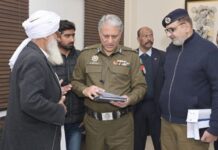By Amjed Jaaved
Pakistan has approached the United Nations to investigate the recent attack on a United Nations’ Military Observers’ Group vehicle. This is not the first time India has done so to harass the UNMOGIP.
Pakistan’s recourse to the UN is India’s Achilles Heel. So it is as India’s stand on disputed Kashmir is a rigmarole of inconsistent myths.
To avoid internationalization of the Kashmir issue, India’s own former foreign secretary Jagat Singh Mehta offered proposals (rebranded by Parvez Musharraf) to soften the LOC in exchange for non-internationalisation of the Kashmir dispute for 10 years. Mehta presented his ideas in an article, ‘Resolving Kashmir in the International Context of the 1990s’.
India had no consistent stand on Kashmir. There was a time when Sardar Patel presented Kashmir to Pakistan in exchange for Hyderabad and Junagadh. Reportedly, the offer was declined as Pakistan’s prime minister Liaquat Ali Khan thought it could retain not only Kashmir but also the other two. Jawaharlal Nehru approached the United Nations’ for mediation. He kept harping his commitment to the plebiscite.
However, at heart, he did not care about the disputed state’s constituent assembly, Indian parliament or the United Nations. Nehru discarded Maharajah’s and Kashmir assembly’s ‘accession’; in a letter dated 31 October 1947, addressed to the disputed state’s prime minister, he shrugged off ‘accession’. He reiterated in New Delhi on 3 November 1951, that ‘we have made it perfectly clear before the Security Council that the Kashmir Constituent Assembly does not [insofar] as we are concerned come in the way of a decision by the Security Council, or the United Nations’. Again, at a press conference on 11 June 1951, he was asked if the proposed the constituent assembly of Kashmir ‘decides in favour of acceding to Pakistan, what will be the position?’ he reiterated, ‘We have made it perfectly clear that the Constituent Assembly of Kashmir was not meant to decide finally any such question, and it is not in the way of any decision which may ultimately flow from the Security Council proceedings’. He re-emphasised his view once again at tat press conference, “we have made it perfectly clear before the Security Council that the Kashmir Constituent Assembly does not [insofar as] we are concerned come in the way of a decision by the Security Council or the United Nations.” At a press conference on 24 July 1952, when asked what the necessity of plebiscite was now that he had got [accession by] the Constituent Assembly, he replied “Maybe theoretically you may be right. But we have given them assurance and we stand by it.”
Following Simla Accord (1972), India stopped reporting ceasefire skirmishes to the UN. But, Pakistan has been consistently reporting all such violations to the UN. India feigns it does not recognise the UNMOGIP. But, then it provides logistic support to the UMOGIP on its side of the LOC for reporting mostly on basis of newspaper reports.
India keeps harassing the UNMOGIP vehicles occasionally. Not long ago, three members of the UNMOGIP had a close call along the LoC in Azad Jammu and Kashmir after Indian troops shot at and injured two locals who were briefing them on the situation after ceasefire violations.
India even asked UNMOGIP to vacate 1/AB, Purina Lila Road, Connaught Place, from where it has been functioning since 1949.
Given the discord between both countries over UNMOGIP’s mandate and functions, the Secretary General has said in the past that the group could be terminated but only through a decision of the Security Council UNMOGIP is financed through the UN regular budget.
UNMOGIP derives its authority from the 21 Aril 198 Security Council Resolution that empowered the United Nations Commission for India and Pakistan to establish “such observers as it may require.”
Professor Rosalyn Higgins, later an ICJ Judge, said in 1970 that “this resolution would seem clearly to fall within the terms of Article 40 of the U.N.’s Charter even though that Article was not specifically mentioned. The authority for establishing UNMOGIP thus emanates from Chapter VII rather than Chapter VI.” Article 40 authorises the Council to “call upon the parties to comply with such provincial measures as it deems necessary.” Chapter VI pertains to disputes on which the Council can make “recommendations.” Chapter VII deals with acts of aggression on which it “decides.”
The UNMOGIP authority was confirmed when the UNCIP was replaced by a Special Representative, Sir Owen Dixon, on 30 March 1951 by declaring that the “Group shall continue to supervise the cease-fire in the State”. It functions under the control and supervision of the Secretary-General. After the 1965 War, India-Pakistan Observation Mission soon vanished; UNMOGIP survived. The Tashkent Declaration also bound the parties to withdraw “to the positions they held prior to August 5, 1965, and “observe the ceasefire terms on the ceasefire line.”
On 1 October 1972, UN Under-Secretary General C.V. Narasimhan said in New Delhi: “there has been no written request from New Delhi to withdraw UN Observers from the Indian side of the old ceasefire line in Jammu and Kashmir.” He added they were there under a Security Council resolution followed by an India-Pakistan agreement. They could not be withdrawn as long as the resolution remained. This was said after the Simla Accord, which simply stated that “in Jammu and Kashmir, the line of control resulting from the ceasefire of December 17, 1971 shall be respected by both sides without prejudice to the recognized position of either side”.
Till 1953, India was, at least verbally, committed to the plebiscite. But it has since been making frantic efforts to warp the United Nation Organization and woo the USA in her favour. For instance, during the temporary absence of Pakistan’s representative India tried to get the `India-Pakistan Question’ deleted from the UN agenda.
India based her plea on the Security Council’s 1996 informal decision about deleting dormant questions. The Question was deleted, but was restored to the agenda upon the Pakistan representative’s arrival.
At India’s behest, US Congressman Stephen Solarz elicited the statement from Bush-administration high-level diplomat, John H. Kelly, that a plebiscite was no longer possible.
To India’s chagrin, John R. Mallot, the US State Department’s point man for South Asia in 1993, corrected Kelly’s faux pas. He told the House Foreign Affairs Sub-Committee on Asia and the Pacific on April 28, 1993 that Kelly ‘misspoke’ in 1990 when he said that the United States no longer believed a plebiscite was necessary in South Asia.
There is no UNO resolution abolishing the UNMOGIP role. Similarly, there is no resolution incorporating India’s volte face that India-occupied Kashmir had acceded to India through the so-called state assembly’s resolution.
A subsequent accession resolution, passed by the occupied Kashmir’s ‘constituent assembly’ is also void. This resolution violates the Security Council’s resolutions forbidding India from going ahead with the accession farce.
Aware of India’s intention to get the ‘Instrument of Accession’ rubber-stamped by the puppet assembly, the Security Council passed two resolutions to forestall the `foreseeable accession’. Security Council’s Resolution 9 of 30 March 1951 and affirmative Resolution 122 of 24 March 1957 outlaws accession or any other action to change status of the Kashmir. India’s belligerence is an open invitation to war, perhaps a nuclear Armageddon. India’s attitude negates the cardinal principles in inter-state relations, that treaties are to be observed. India qualifies as a rogue state. It should be shunned as a pariah and subjected to sanctions.






















